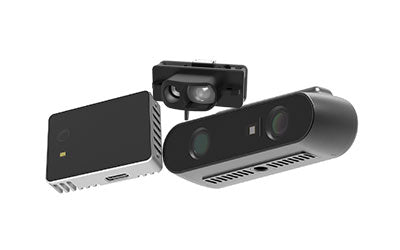ToF Sensors for Drone Distance Measurement: Precision and Automation

As drone technology rapidly evolves, precise distance measurement has become essential for widespread applications across various industries. ToF (Time-of-Flight) sensors, known for their high-precision distance measurement capabilities, enable drones to provide real-time depth sensing and flight distance calculations.
By measuring the time delay of light pulses reflected from objects, ToF sensors—including laser distance sensors—not only deliver highly accurate distance data but also generate 3D point clouds and depth maps. These capabilities support drones in precise positioning, obstacle avoidance, and measurement tasks in complex environments such as indoor drone operations. The application of drones equipped with ToF camera sensors demonstrates significant potential in fields like photography, surveying, logistics, and industrial inspection.
How ToF Sensors Work
What does a ToF sensor do?
A ToF sensor emits light pulses and measures the time of flight (the time it takes for the pulses to reflect back) from a target object. This allows the drone to calculate the exact distance to objects or the ground. Each light pulse returns with a time flight calculation, providing precise distance sensor data that is converted into 3D depth camera information.
This distance measurement method is not only fast and accurate but also maintains consistent performance under various lighting conditions. Drones equipped with ToF sensors can measure distances to the ground, obstacles, or buildings in real-time, supporting navigation, obstacle avoidance, and measurement tasks even in challenging environments such as counter rooms or industrial spaces.
Advantages of ToF Sensors for Drone Distance Measurement
-
High Precision and Real-Time Feedback
ToF sensors, including laser distance sensors, offer centimeter or millimeter-level accuracy, allowing drones to calculate flight distance and nearby object positions in real-time. This high precision is essential for applications requiring accurate data, whether it’s monitoring terrain during outdoor flights or measuring distances in industrial settings. Indoor drones benefit significantly from this real-time feedback, improving stability and accuracy in confined environments like counter rooms. -
Adaptation to Complex Environments
ToF sensors function effectively in both open and complex environments. Unlike other distance sensors, ToF camera sensors are less affected by lighting conditions, maintaining accurate measurements in low-light, reflective, or overly bright environments. This is especially useful in night-time operations or complex scenarios where drone avoid obstacles is crucial. -
Fast Response and Obstacle Avoidance
With the ability to rapidly calculate distances, ToF sensors help drones adjust flight paths and avoid obstacles in real-time. This is critical when flying in environments dense with obstacles, such as forests, urban areas, or indoor spaces. ToF sensors continually provide flight distance data to help drones avoid collisions, enhancing their flexibility and safety in tight areas. -
Accurate Altitude Measurement and Hovering
Drones equipped with ToF sensors can maintain consistent altitudes by accurately measuring their distance from the ground. This is particularly important for tasks like aerial photography, where altitude stability is key, or in agriculture, where drones must maintain a consistent height for pesticide spraying or fertilization.
Applications of ToF Sensors for Drone Distance Measurement
-
Construction and Building Monitoring
In construction, drones with ToF sensors measure building heights, structural distances, and monitor progress. These measurements require high precision, and ToF sensors allow drones to quickly gather data, supporting construction management and safety evaluations. -
Surveying and Terrain Modeling
In terrain mapping, ToF sensors help drones capture height differences and create 3D models. The ability to measure detailed flight distances across terrains enhances environmental research, disaster prevention, and urban planning. -
Industrial Inspection and Maintenance
For industrial inspections, drones with ToF sensors can measure distances and angles of machinery, helping engineers assess equipment status. In industries such as oil, gas, and energy, drones equipped with laser distance sensors provide critical data for maintenance while reducing the need for manual inspections. -
Precision Agriculture
In agriculture, ToF sensors measure the height of crops, enabling drones to adjust spraying heights for even distribution. ToF sensors support precision farming by providing real-time feedback, ensuring accurate crop monitoring and resource management. -
Logistics and Warehouse Management
In warehouses, ToF sensors measure distances between shelves and goods, helping drones locate and manage inventory. The use of ToF camera sensors in logistics sorting centers enhances package identification and routing efficiency.
Future Development of ToF Sensors for Drone Distance Measurement
-
Higher Precision Distance Measurement
As ToF sensor technology advances, the measurement accuracy will reach millimeter or even micrometer levels, opening up applications in scientific research and precision industry. -
Multi-Sensor Fusion
Future drones will integrate ToF sensors with other technologies, such as depth cameras, LiDAR, and infrared sensors, providing a more comprehensive environmental understanding. This multi-sensor fusion will allow drones to not only measure distances but also identify object shapes, textures, and materials. -
AI-Enhanced Sensing
The integration of AI with ToF sensors will enable drones to adapt to different measurement environments and optimize flight paths based on real-time data. AI can also enhance the ability of drones to avoid obstacles in complex environments, further improving their versatility.
Conclusion
Drones equipped with ToF sensors, including laser distance sensors and ToF camera sensors, offer an efficient and precise solution for distance measurement in various industries. From construction monitoring and terrain mapping to industrial inspection and precision agriculture, ToF sensors allow drones to gather real-time distance data, ensuring safe flight and successful mission execution. With continued advancements, ToF sensors will become even more integral to the future of drone technology, supporting innovative applications across numerous fields.
Synexens 3D Of RGBD ToF Depth Sensor_CS30
Our professional technical team specializing in 3D camera ranging is ready to assist you at any time. Whether you encounter any issues with your TOF camera after purchase or need clarification on TOF technology, feel free to contact us anytime. We are committed to providing high-quality technical after-sales service and user experience, ensuring your peace of mind in both shopping and using our products
-
Publicado en
CS30






